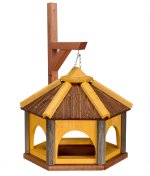JayFeatherPL
Well-known member

Tube feeders contain a supply of seeds, so you don't have to fill this feeder that often and the tube is protected from the environment, but the moisture and coldness can get into the tube by the holes from which the birds get seeds, so these seeds can become a breeding ground for mold and bacteria. The tube feeders also extend an inch or more below the bottom-most feeding ports and mold and bacteria can breed here too, but you can block the bottom of the tube so It's not that big problem. Other advantages of this type of feeder is that the birds don't defecate where they eat, so they don't eat seeds from the feces and they forage separately.
House feeders need to be regularly filled and the rain or snow can easily fall on the seeds, when there's a strong wind. Of course seeds are also threatened by the moisture in the air and birds defecate where they eat and they can forage in large number at the same place.
Automatic feeders (with the seed dispenser) also have a supply of seeds, but the seeds are at the edge of the feeder so in this feeder, seeds are the most threatened by the rain, snow and moisture. The advantage is that the birds don't defecate where they eat, and they forage separately, but they can also forage in big numbers. The moisture can also get inside by the gap at the bottom and this type of feeder should be airtight.
What is your opinion about these feeders? Which is the safest for birds?
The first photo is the tube feeder, the second one and the third one are automatic feeder, and the fourth one is the house feeder - every file is named too. (These are not my photos!)
House feeders need to be regularly filled and the rain or snow can easily fall on the seeds, when there's a strong wind. Of course seeds are also threatened by the moisture in the air and birds defecate where they eat and they can forage in large number at the same place.
Automatic feeders (with the seed dispenser) also have a supply of seeds, but the seeds are at the edge of the feeder so in this feeder, seeds are the most threatened by the rain, snow and moisture. The advantage is that the birds don't defecate where they eat, and they forage separately, but they can also forage in big numbers. The moisture can also get inside by the gap at the bottom and this type of feeder should be airtight.
What is your opinion about these feeders? Which is the safest for birds?
The first photo is the tube feeder, the second one and the third one are automatic feeder, and the fourth one is the house feeder - every file is named too. (These are not my photos!)









